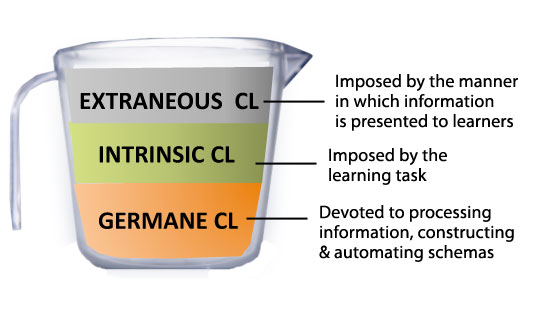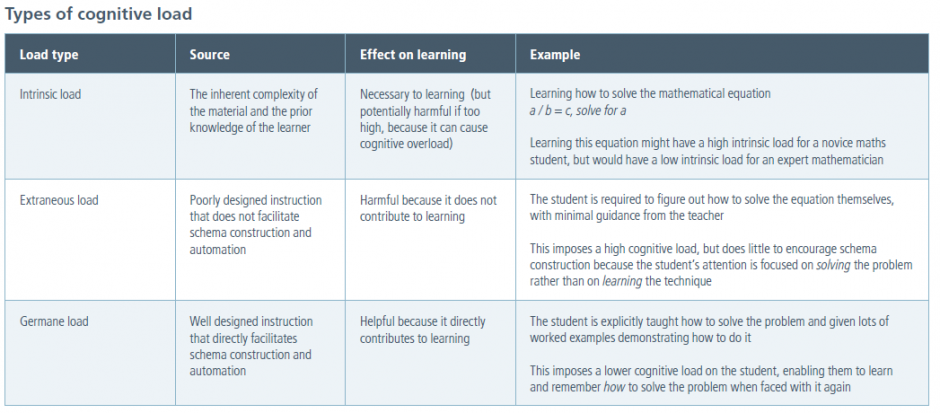Cognitive load theory was recently described by British educationalist Dylan Wiliam as ‘the single most important thing for teachers to know’ (Wiliam 2017).
My longest ever blog post title is not a professed assertion, rather a quote from Dylan Wiliam.
Cognitive load theory (CLT) seems to be the topic of the year. Signposted by Greg Ashman a few times in recent months, mentioned by Tom Sherrington, it appears to be the education research topic of the year. I listened to a podcast on the way back from Pedagoo Hampshire, reviewed a few previously “starred” blog posts and watched a couple of short videos. For now, I book marked the 517 links from Google Scholar from the past 12 months. Clearly, possibly ironically, I should have been paying more attention.
So here I am paraphrasing the recent Centre for Education Statistics and Evaluation paper – “Cognitive load theory: Research that teachers really need to understand.” It is written in plain English and is very accessible. Thanks again to Greg Ashman.
Need to know
Cognitive load theory is built upon two commonly accepted ideas. The first is that there is a limit to how much new information the human brain can process at one time. The second is that there are no known limits to how much stored information can be processed at one time. p2
CLT assumes that knowledge is stored in long-term memory. Long-term memory is the memory system where large amounts of information are stored semi-permanently (if you have watched Pixar’s “Inside Out” this will be familiar). Cognitive load theory assumes that knowledge is stored in long-term memory in the form of ‘schemas.’ Two further points, there is no limit to how complex schemas can become and automaticity occurs after extensive practice (Sweller, van Merrienboer & Paas 1998, p. 256).
A schema organises elements of information according to how they will be used. According to schema theory, skilled performance is developed through building ever greater numbers of increasingly complex schemas by combining elements of lower level schemas into higher level schemas.
Schema provide a system for organising and storing knowledge. Second, and crucially for cognitive load theory, they reduce working memory load or, in effect, bypass the limits of working memory, or allow it to be reallocated by allowing information to be accessed automatically. Importantly
“any instructional design that flouts or merely ignores working memory limitations inevitably is deficient.(Sweller, van Merrienboer & Paas 1998, pp. 252-253)”
Cognitive load theory identifies three different types of cognitive load: intrinsic, extraneous and germane load (see Sweller 2010; Sweller, van Merrienboer & Paas 1998). I could offer an explanation here, but the CESE table is excellent at outlining and explaining them.
I felt that there were three other key statements
- Two factors influence intrinsic cognitive load: the complexity of the material, and the prior knowledge of the learner (Sweller, van Merrienboer & Paas 1998).
- Cognitive load theorists consider that instructional design will be most effective when it minimises extraneous load in order to free up the capacity of working memory.
- Germane cognitive load refers to the load imposed on the working memory by the process of learning – that is, the process of transferring information into the long-term memory through schema construction (Sweller, van Merrienboer & Paas 1998, p. 259).
Whilst the CLT is gaining a lot of attention right now, it is not without its detractors. Questions regarding the definitions of cognitive load, concerns about the methodological rigour of the research, and issues with its external generalisability persist.
What are the practical implications of CLT for educators?
Here we stumble back to the progressive-constructivist dichotomy. Direct instruction as opposed to discovery. Sweller is very clear here and cites “decades of research.”
It is important to note that cognitive load theorists do not advocate using all aspects of explicit instruction all the time. Indeed, they recognise the need for learners to be given the opportunity to work in groups and solve problems independently – but assert this should be used as a means for practicing newly learnt content and skills, not to discover information themselves (Clark, Kirschner & Sweller 2012, p. 6).
Reflections from teaching. If working memory is overloaded, there is a greater risk that the content being taught will not be understood by the learner, will be misinterpreted or confused, will not be effectively encoded in long-term memory.
The ‘worked example effect.’
Provide a worked example. With every step fully explained and clearly shown. Unguided problem-solving places a heavy burden on working memory, inhibiting the ability of the learner to transfer the information into their long-term memory. Even though the learner may effectively solve the problem, but because their working memory was overloaded, they may not recognise and remember the rule that would allow them to quickly solve the same problem again in the future.
The ‘expertise reversal effect.’
Worked examples are effective for novices, less effective for learners as they gain expertise.
The ‘split attention effect.’
Keep diagrams with the text. It is unreasonable to expect learners to hold both sources working memory.
The ‘redundancy effect.’
Keep the initial instructions concise, self-paced or considerately paced. Single channels: Text. Audio. Visual. Requiring learners to process redundant information inhibits learning because it overloads working memory.
The ‘modality effect.’
Either written on the board or on the worksheet / text book. Don’t read your slides or worksheets out loud.
Cognitive load theory is particularly relevant to teaching novice learners in so-called ‘technical’ domains such as mathematics, science and technology.
CLT and teaching maths
Previously I have used a learning journey map that outlines our scheme of learning, that charts our progress. This slide starts the first lesson only, from here on it is the second slide displayed in every lesson thereafter. The first slide is a recap quiz, low stakes, that reviews a sample of the previous lessons content. It is a different colour and very much like a “do it now task.” The lesson outline and what the students will be learning, reviewing, practicing follows. I often include a visual puzzle or example for them to connect the learning to real life. There is no right answer, encourages interaction and the use of subject specific language.
I do not read out slides (the ‘redundancy effect’) and I like to use icons to direct and simplify instructions. Men at work sign – students are silent working. Nintendo flag – the aim or a marker. Worked examples appear and stay on the board, often the Men at work sign is added.
I probably gave my students too much information and not enough time between instructions. I am not sure, as an inexperienced maths teacher, I was able to judge the load; extraneous, intrinsic or germane.
Most teachers will be familiar with the limitation of working memory and possibly the limitations of having to switch channels or operate dual channels. However, my prior know about working memory (Miller 7+/-2) was widely inaccurate and over estimating the capacity of working memory. In fact, much more than two, at best three sources, is likely to fill working memory. Do not ask students to compare more than three items.
I’ve more reading here. Meanwhile, I am hoping that I have keep the load workable?




Pingback: Working memory – takeaways and reflections (part IV) – Edventures